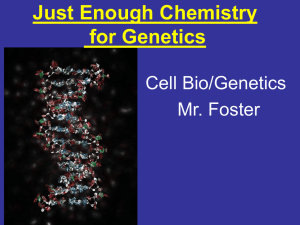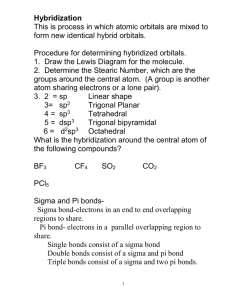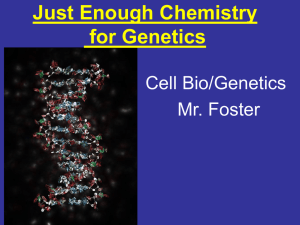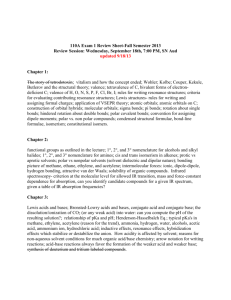Chemistry 111 Study Sheet
advertisement
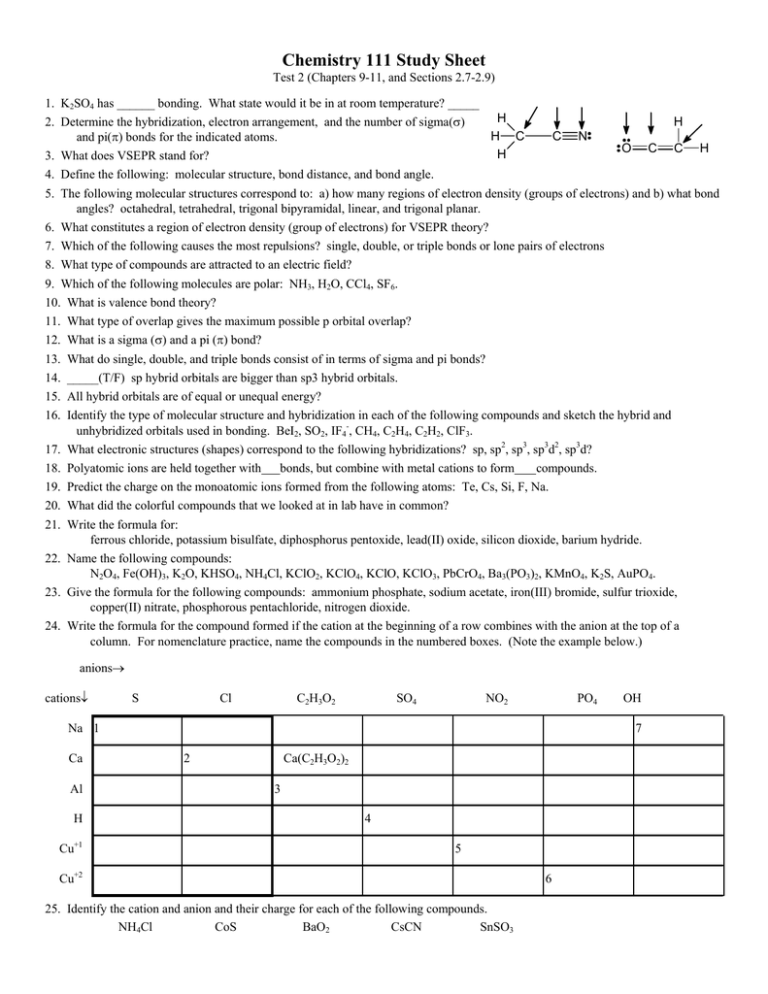
Chemistry 111 Study Sheet Test 2 (Chapters 9-11, and Sections 2.7-2.9) 1. K2SO4 has ______ bonding. What state would it be in at room temperature? _____ H 2. Determine the hybridization, electron arrangement, and the number of sigma(σ) H H C C N and pi(π) bonds for the indicated atoms. O C C H H 3. What does VSEPR stand for? 4. Define the following: molecular structure, bond distance, and bond angle. 5. The following molecular structures correspond to: a) how many regions of electron density (groups of electrons) and b) what bond angles? octahedral, tetrahedral, trigonal bipyramidal, linear, and trigonal planar. 6. What constitutes a region of electron density (group of electrons) for VSEPR theory? 7. Which of the following causes the most repulsions? single, double, or triple bonds or lone pairs of electrons 8. What type of compounds are attracted to an electric field? 9. Which of the following molecules are polar: NH3, H2O, CCl4, SF6. 10. What is valence bond theory? 11. What type of overlap gives the maximum possible p orbital overlap? 12. What is a sigma (σ) and a pi (π) bond? 13. What do single, double, and triple bonds consist of in terms of sigma and pi bonds? 14. _____(T/F) sp hybrid orbitals are bigger than sp3 hybrid orbitals. 15. All hybrid orbitals are of equal or unequal energy? 16. Identify the type of molecular structure and hybridization in each of the following compounds and sketch the hybrid and unhybridized orbitals used in bonding. BeI2, SO2, IF4-, CH4, C2H4, C2H2, ClF3. 17. What electronic structures (shapes) correspond to the following hybridizations? sp, sp2, sp3, sp3d2, sp3d? 18. Polyatomic ions are held together with bonds, but combine with metal cations to form compounds. 19. Predict the charge on the monoatomic ions formed from the following atoms: Te, Cs, Si, F, Na. 20. What did the colorful compounds that we looked at in lab have in common? 21. Write the formula for: ferrous chloride, potassium bisulfate, diphosphorus pentoxide, lead(II) oxide, silicon dioxide, barium hydride. 22. Name the following compounds: N2O4, Fe(OH)3, K2O, KHSO4, NH4Cl, KClO2, KClO4, KClO, KClO3, PbCrO4, Ba3(PO3)2, KMnO4, K2S, AuPO4. 23. Give the formula for the following compounds: ammonium phosphate, sodium acetate, iron(III) bromide, sulfur trioxide, copper(II) nitrate, phosphorous pentachloride, nitrogen dioxide. 24. Write the formula for the compound formed if the cation at the beginning of a row combines with the anion at the top of a column. For nomenclature practice, name the compounds in the numbered boxes. (Note the example below.) anions→ cations↓ S Cl C2H3O2 SO4 NO2 PO4 Na 1 Ca Al H Cu+1 OH 7 2 Ca(C2H3O2)2 3 4 5 Cu+2 25. Identify the cation and anion and their charge for each of the following compounds. NH4Cl CoS BaO2 CsCN SnSO3 6

